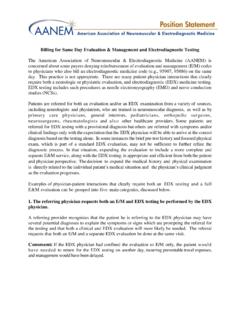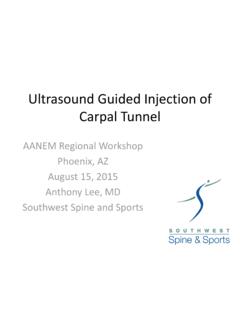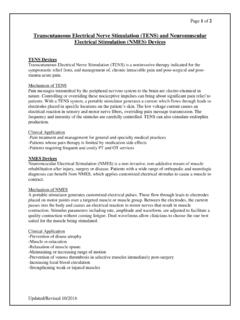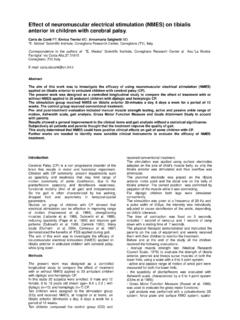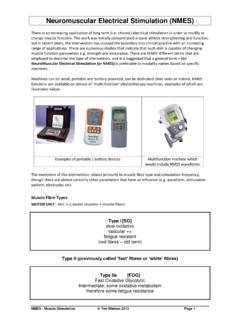Transcription of NEUROMUSCULAR ELECTRICAL STIMULATION IN …
1 INVITED REVIEWABSTRACT: This review provides a comprehensive overview of the clini-cal uses of NEUROMUSCULAR ELECTRICAL STIMULATION (NMES) for functional andtherapeutic applications in subjects with spinal cord injury or stroke. Func-tional applications refer to the use of NMES to activate paralyzed muscles inprecise sequence and magnitude to directly accomplish functional tasks. Intherapeutic applications, NMES may lead to a specific effect that enhancesfunction, but does not directly provide function. The specific neuroprostheticor functional applications reviewed in this article include upper- and lower-limb motor movement for self-care tasks and mobility, respectively, bladderfunction, and respiratory control.
2 Specific therapeutic applications includemotor relearning, reduction of hemiplegic shoulder pain, muscle strength-ening, prevention of muscle atrophy, prophylaxis of deep venous thrombo-sis, improvement of tissue oxygenation and peripheral hemodynamic func-tioning, and cardiopulmonary conditioning. Perspectives on futuredevelopments and clinical applications of NMES are Nerve35:562 590, 2007 NEUROMUSCULAR ELECTRICAL STIMULATIONIN NEUROREHABILITATIONLYNNE R. SHEFFLER, MD, and JOHN CHAE, MDCleveland Functional ELECTRICAL STIMULATION Center, Case Western Reserve University,2500 MetroHealth Drive, Cleveland, Ohio 44109, USAA ccepted 4 January 2007 This article provides a comprehensive review of theclinical uses of NEUROMUSCULAR ELECTRICAL STIMULATION (NMES) in neurological rehabilitation.
3 NMES refersto the ELECTRICAL STIMULATION of an intact lower motorneuron (LMN) to activate paralyzed or paretic mus-cles. Clinical applications of NMES provide either afunctional or therapeutic benefit. Moe and Post207introduced the term functional ELECTRICAL stimula-tion (FES) to describe the use of NMES to activateparalyzed muscles in precise sequence and magni-tude so as to directly accomplish functional tasks. Inpresent-day applications, functional tasks may in-clude standing or ambulatory activities, upper-limbperformance of activities of daily living, and controlof respiration and bladder function.
4 A neuropros-thesis is a device or system that provides FES. Accord-ingly, a neuroprosthetic effect is the enhancement offunctional activity that results when a neuroprosthe-sis is utilized. NMES is also used for therapeuticpurposes. NMES may lead to a specific effect thatenhances function but does not directly providefunction. One therapeutic effect is motor relearn-ing, which is defined as the recovery of previouslylearned motor skills that have been lost followinglocalized damage to the central nervous system. 180 Evolving basic science and clinical studies on centralmotor neuroplasticity now support the role of activerepetitive-movement training of a paralyzed limb.
5 Ifactive repetitive-movement training facilitates motorrelearning, then NMES-mediated repetitive-move-ment training may also facilitate motor examples of therapeutic applications includetreatment of hemiplegic shoulder pain, cardiovascu-lar conditioning, treatment of spasticity, and preven-tion of muscle atrophy, disuse osteoporosis, anddeep venous thrombosis (DVT).This review focuses on the clinical uses of NMESfor functional and therapeutic applications in pa-tients with spinal cord injury or stroke. In order toprovide a foundation for the various clinical appli-cations, the neurophysiology of NMES and compo-Available for Category 1 CME credit through the AANEM :ANN, artificial neural network; DVT, deep venous thrombo-sis; ECU, external control unit; EMG, electromyography; FES, functional elec-trical STIMULATION ; Fint, fatigue-intermediate; FR, fatigue-resistant; LMN, lowermotor neuron; LSU-RGO, Louisiana State University Reciprocating Gait Or-thosis; LTP, long-term potentiation; MHC, myosin heavy chain.
6 MRI, magneticresonance imaging; NMES, NEUROMUSCULAR ELECTRICAL STIMULATION ; PG/PS, pat-tern generator / pattern shaper; PID, proportional integral derivative; RF, ra-diofrequency; ROM, range of motion; SCI, spinal cord injury; TENS, transcu-taneous ELECTRICAL nerve STIMULATION ; UMN, upper motor neuronKey words:bladder function; functional ELECTRICAL STIMULATION ; motor relearn-ing; NEUROMUSCULAR ELECTRICAL STIMULATION ; neuroprosthesis; rehabilitation; re-spiratory control; spinal cord injury; strokeCorrespondence Sheffler; e-mail: 2007 Wiley Periodicals, online 13 February 2007 in Wiley InterScience ( ).
7 DOI ELECTRICAL StimulationMUSCLE & NERVE May 2007nents of NMES systems are briefly reviewed. Thespecific neuroprosthetic or functional applicationsinclude upper- and lower-limb motor movement forself-care tasks and mobility, respectively, bladderfunction, and respiratory control. Specific therapeu-tic applications include poststroke motor relearningas well as the examples mentioned earlier. Lastly,perspectives on future developments and clinical ap-plications of NMES are OF NMESNMES is initiated with the excitation of peripheralnervous tissue.
8 The mathematical characterization ofneuronal action potential generation is largely predi-cated on the seminal work of scientists and neurophysi-ologists including Galvani,106 Lapicque175andHodgkin and recently, McNeal200mathematically defined the time course of events fol-lowing stimulus application to the propagation of theaction potential in a normal healthy myelinated term stimulus threshold defines the lowest levelof ELECTRICAL charge that generates an action all or none phenomenon of the action potentialproduced by natural physiologic means is identical tothe action potential induced by of impulses in a nerve is influencedconsiderably by the nerve s cable and Rushton in 1946131used extracellularelectrodes to measure
9 Applied current along lobsteraxons to describe the spread of current along nervefibers of uniform diameter composed of a centralconductor and insulating sheath. Nerve fiber recruit-ment and resultant force characteristics of musclecontraction are modulated by both stimulus pulsewidth277and stimulus variablesinclude distance from the stimulating electrode andmembrane capacitance. The threshold for eliciting anerve fiber action potential is 100 to 1,000 times lessthan the threshold for muscle fiber , clinical NMES systems stimulate either thenerve directly or the motor point of the nerve prox-imal to the NEUROMUSCULAR nerve fiber recruitment properties elicitedby NMES differ from those elicited by normal phys-iologic means.
10 An action potential produced by nor-mal physiologic mechanisms initially recruits thesmallest-diameter neurons prior to recruitment oflarger-diameter fibers, such as alpha motor one of the first researchers toexamine the theoretical relationship between fiberdiameter and conduction velocity. Hodgkin132pro-posed that the velocity of action potential propaga-tion should vary directly with the square root of thefiber diameter. The Henneman size principle of vol-untary motor unit recruitment described this pro-gressive size-dependent recruitment of et in detail thisrelationship between fiber diameter and conductionvelocity in peripheral nerve.
